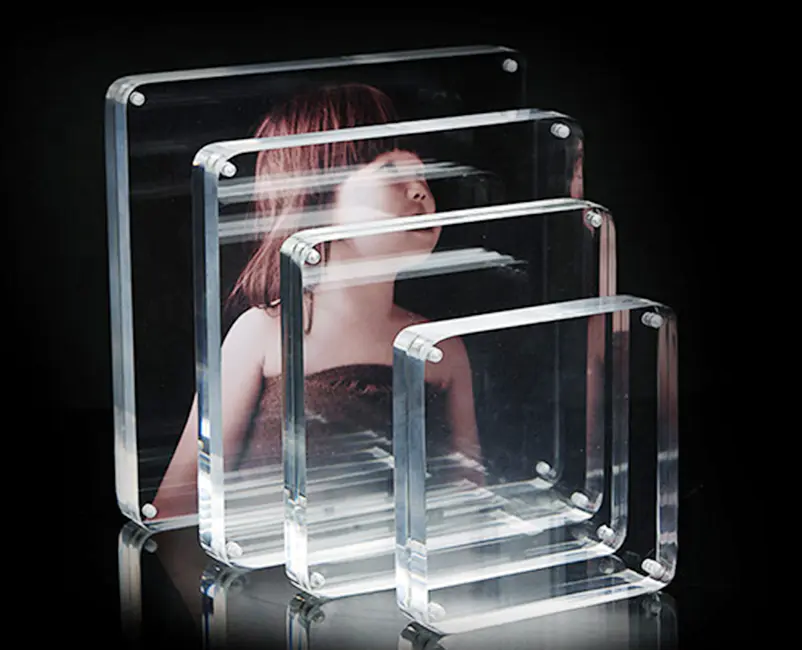Ensuring that the thickness of Acrylic Photo Frame Sheet is uniform and the surface is smooth is a key step in the production process, which directly affects the aesthetics, durability and functionality of the product. The following is a detailed analysis of how to achieve this goal from the aspects of material selection, manufacturing process, equipment precision and quality control:
1. Material selection and formulation optimization
(1) High-purity raw materials
Use high-purity methyl methacrylate (MMA) as the raw material to reduce the impurity content and avoid bubbles or surface defects caused by impurities.
Ensure high monomer conversion during polymerization to avoid bubbles formed by residual unreacted monomers.
(2) Additive selection
Adding appropriate amounts of anti-aging agents and UV stabilizers to the formula can improve the durability of the sheet and reduce surface oxidation.
Use additives with good rheology to ensure that the melt flows evenly during processing and avoid uneven thickness.
2. Manufacturing process optimization
(1) Casting molding process
Mold design: The mold surface must be highly polished to ensure a smooth and flawless sheet surface.
Temperature control: strictly control the temperature and time of the polymerization reaction to avoid uneven sheet thickness or excessive internal stress due to temperature fluctuations.
Pressure uniformity: maintain uniform pressure distribution during the casting process to ensure consistent thickness when the melt fills the mold.
(2) Extrusion molding process
Extruder screw design: optimize the screw structure and compression ratio to ensure uniform heating of the melt during extrusion.
Die design: the die outlet shape and size need to be precisely designed to ensure uniform sheet thickness.
Cooling system: use uniform cooling devices (such as air cooling or water cooling) after extrusion to avoid sheet deformation due to uneven cooling speed.
3. Equipment accuracy and control
(1) Precision equipment
Use high-precision extruders or casting equipment equipped with real-time monitoring systems to ensure that production parameters (such as temperature, pressure, and speed) are always in the optimal range.
Install an online thickness gauge to monitor sheet thickness in real time and automatically adjust process parameters to correct deviations.
(2) Temperature control and pressure control
During the extrusion or casting process, ensure that the temperature distribution of the heating plate and cooling system is uniform to avoid local overheating or insufficient cooling.

Use a multi-zone temperature control system to ensure that the temperature of each part of the equipment is consistent.
4. Surface treatment technology
(1) Polishing process
Mechanically polish or flame polish the finished plate to remove tiny scratches on the surface and improve the gloss.
During flame polishing, the flame intensity and movement speed must be controlled to avoid excessive heating and deformation of the plate.
(2) Coating technology
Applying a layer of transparent protective coating (such as hard coating or anti-scratch coating) on the surface of the plate can not only improve the surface smoothness, but also enhance the wear resistance and scratch resistance.
5. Quality control and inspection
(1) Thickness inspection
Use a micrometer or multi-point thickness gauge to measure the thickness at different locations of the plate to ensure overall uniformity.
Set a thickness tolerance range (such as ±0.1mm). Products outside the range need to readjust the process or be scrapped.
(2) Surface inspection
Use optical inspection equipment (such as laser scanners or visual inspection systems) to check whether there are bubbles, scratches or other defects on the surface of the plate.
For high-end products, manual visual inspection can be used to ensure that there are no obvious defects on the surface.
(3) Stress test
Use a polarizing stress meter to detect the internal residual stress of the plate to avoid deformation or cracking due to excessive internal stress.
Through scientific design and strict production management, the problems of uneven thickness and surface defects can be effectively solved, thereby improving the aesthetics and reliability of the product.
 English
English 中文
中文 Español
Español


